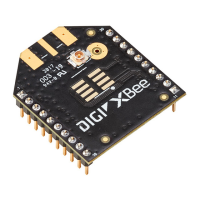Transmission, addressing, and routing Transmission timeouts
Digi XBee® 3 Zigbee® RF Module
118
Field composition
0x001F length
0x11 Explicit transmit request
0x01 Frame ID (set to a non-zero value to enable the transmit status message,
or set to 0 to disable)
0x00000000 0000FFFF 64-bit address for a broadcast transmission
0xFFFE Set to this value for a broadcast transmission
0x00 Source endpoint
0x00 Destination endpoint
0x0000 Cluster ID (Network Address Request)
0x0000 Profile ID (Zigbee device profile)
0x00 Broadcast radius
0x00 Tx Options
0x44 Transaction sequence number
0x34124040 00A21300
00 00
Required payload for Network Address Request command
0x33 Checksum (0xFF - SUM (all bytes after length))
Description
This API frame sends a broadcast ZDO Network Address Request to obtain the 16-bit address of a
device with a 64-bit address of 0x0013A200 40401234. We inserted the bytes for the 64-bit address in
little endian byte order. You must insert data for all multi-byte fields in the API payload of a ZDO
command in little endian byte order. You must set the AO command correctly on an API device to
enable the explicit API receive frames to receive the ZDO response.
Transmission timeouts
The Zigbee stack includes two kinds of transmission timeouts, depending on the nature of the
destination device. Destination devices such as routers with receivers always on use a unicast
timeout. The unicast timeout estimates a timeout based on the number of unicast hops the packet
should traverse to get data to the destination device. For transmissions destined for end devices, the
Zigbee stack uses an extended timeout that includes the unicast timeout (to route data to the end
device's parent), and it includes a timeout for the end device to finish sleeping, wake, and poll the
parent for data.
The Zigbee stack includes some provisions for a device to detect if the destination is an end device.
The Zigbee stack uses the unicast timeout unless it knows the destination is an end device.
The XBee API includes a transmit options bit that you can set to specify the extended timeout used for
a given transmission. If you set this bit, the extended timeout will be used when sending RF data to
the specified destination. To improve routing reliability, applications set the extended timeout bit
when sending data to end devices if:

